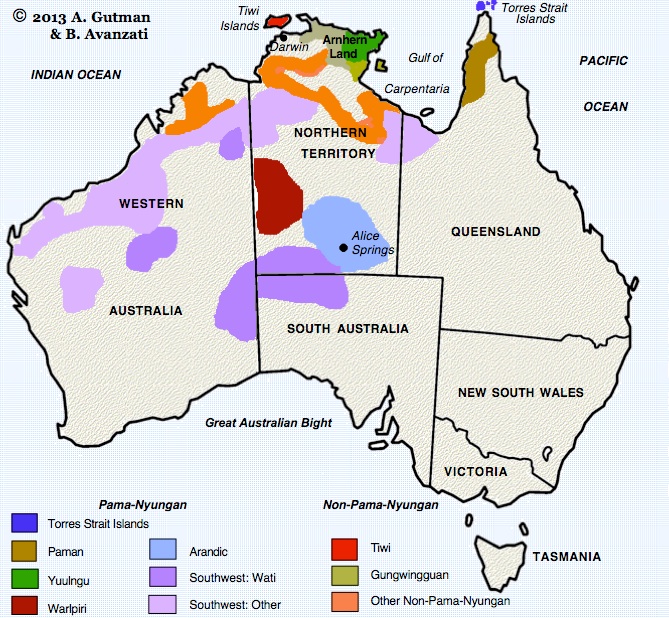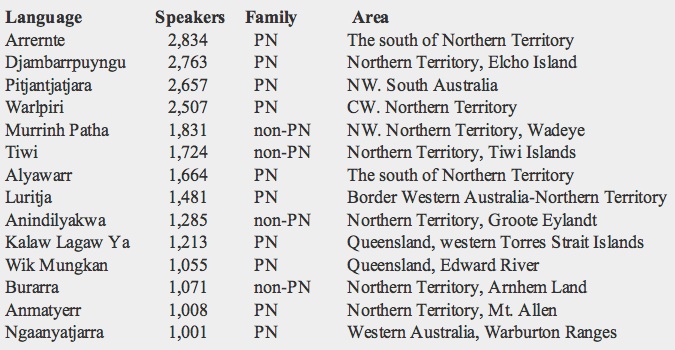An insatiable appetite for ancient and modern tongues


Overview. Australian languages are those spoken by the indigenous inhabitants of Australia who arrived into the island-continent at least 40,000 years ago and subsisted by hunting and gathering. They remained isolated, with little or no contact with other peoples and cultures, until the arrival of the British in the late 18th century. At that time there were some 250 languages spoken by 300,000 to one million people. As a result of cultural marginalization suffered by native Australians, half of the indigenous languages have become extinguished and the number of speakers reduced to a mere 45,000.
Probably, all Australian languages are genetically related though their unity has not been formally proven, and reconstructing Proto-Australian is an arduous task considering the great time-depth involved. Due to their long geographic isolation, the indigenous languages of Australia exhibit some unique characteristics. They are unrelated to other language families.
Distribution. Australian languages are spoken by small communities scattered across the vast continental surface of Australia as well as in some neighboring islands, particularly the western ones of the Torres Strait archipelago. The relation of the poorly documented languages of Tasmania with those of the mainland is uncertain.
Internal classification. Australian languages are divided into two families called Pama-Nyungan and Non-Pama-Nyungan.
Map of indigenous Australian languages

-
a)Pama-Nyungan covers a great chunk of the continent spreading mainly across the southern two-thirds of Australia. It includes several groups and isolates:
-
•The Yuulngu group is a separate Pama-Nyungan enclave in eastern Arnhem Land, isolated from the main block by intervening non-Pama-Nyungan languages. It includes several partly mutually intelligible languages of which the most widely spoken is Djambarrpuyngu.
-
•Torres Strait Islands language, spoken in the western and central islands, whose main dialect is Kalaw Lagaw Ya.
-
•Paman, spoken on the Cape York Peninsula of Queensland, represented by Wik Mungkan and many other languages.
-
•Warlpiri, a language found in the Northern Territory northwest of Alice Springs. It is related to the almost extinct Warlmanpa, and to a small family of central Australia called Ngumpin.
-
•Arandic: a small family integrated by several closely related languages or dialects of which Arrernte, Alyawarr, and Anmatyerr are the most populous.
-
•Southwest, a hypothetical grouping of a variety of diverse languages. It is divided into the Wati subgroup of central Australia, and into several other subgroups predominant in the coast of Western Australia. Wati includes the large Pitjantjatjara, Ngaanyatjarra, and Luritja languages (the last one also called Pintupi).
-
b)The non-Pama-Nyungan family stretches across northernmost Australia, except Queensland, and includes, among others, Tiwi, a language isolate spoken in the Tiwi Islands which is one of the more robust native languages of Australia, and the Gunwingguan group, spread in most of Arnhern Land, whose major languages are Anindilyakwa (Enindhilyagwa) and Burarra. Another relatively large language is Murrinh Patha of disputed classification.
Speakers. According to the 2006 Australian Census the number of indigenous Australian language speakers is 55,682, but, if we discount English-based creole speakers, a more accurate figure is 45,000. 127 languages are still spoken, but 66 of them by less than 100 people each. Indigenous languages with more than one-thousand speakers are:

SHARED FEATURES
-
✦ Phonology
-
- Generally, Australian languages have words composed of more than one syllable. Typically, every word must begin with a single consonant and end in a vowel or a restricted number of consonants. Some languages, though, have words beginning with a vowel. Only a subset of consonants is allowed in initial position and consonant clusters are allowed only intervocalically.
-
- The majority of Australian languages have only three vowels: i, a, u , and some also e or o or both. Half of them have contrasting short and long vowels.
-
- There is usually no voicing contrast for stops. In a given language, all stops are voiced or are all voiceless.
-
- There are contrastive stops at up to five points of articulation, with a nasal for each stop position (most of the world's languages have twice as many stops as nasals). Stops and nasals contrast dental and alveolar manners of articulation. Fricatives and affricates are usually lacking.
-
✦ Morphology
Nominal
-
- Languages of the Pama-Nyungan family are entirely suffixing in their morphology. Nouns are marked for case, and verbs are marked for aspect, tense, and mood. The following cases are typically found in Pama-Nyungan languages: dative, allative (direction towards a place), locative, ablative (source and cause) and, sometimes, genitive. An additional ergative case is used to mark the agent of transitive verbs. Pronouns have also an accusative case.
-
- Non-Pama-Nyungan languages may have both suffixes and prefixes. In non-Pama-Nyungan case-marking is often absent.
-
- Suffixes serve also to derive new words, and among them those meaning ‘having’ and ‘lacking’ are almost universal in Australian languages.
-
- Many of the northern languages have noun class systems though they are exceptional in Pama-Nyungan. They can have from two to eight noun classes, with each class marked by a prefix. At least, they consist of masculine, feminine, and vegetable food classes.
-
- Pronouns generally differentiate three persons, and singular, dual, and plural numbers. The dual and plural first person pronoun distinguish between inclusive and exclusive i.e., 'we with me'/'we without me'. Some languages also show bound pronouns, often these are reduced forms of the free pronouns.
Verbal
-
- Verbs are marked for tense, aspect and imperative mood by suffixes. They are clearly divided between transitive and intransitive. Some languages have a relatively small number of inflectable verbs, necessitating a coverb to add lexical meaning of which there can be a large number. The coverb has little or no inflection and sometimes is fused with the main verb. The most common tense system is past versus non-past, but a distinction between present, past and future is also found as well as a contrast between future and non-future.
-
- After the verbal root a suffix may be inserted to make a verb intransitive, marking it as reflexive or reciprocal. After this optional suffix comes a single obligatory inflectional suffix for tense, aspect and mood.
-
- Non-Pama-Nyungan languages have this same verbal structure but add prefixes to the root that provide complementary information about tense, aspect and mood.
-
- In most non-Pama-Nyungan languages subject and object are frequently incorporated into the verb as pronominal prefixes.
-
✦ Syntax
-
- In most Australian languages word order is relatively free. The relation between words is determined, mainly, by case marking. The focus of the sentence is, usually, placed at the beginning. Some languages have little case marking and in them word order is more restricted. Particles may be employed to affirm, negate, forbid or indicate possibility.
-
- Pama-Nyungan languages display ergativity, a process in which the agent noun of a transitive verb is marked with the ergative case while the subject of an intransitive verb as well as the object of a transitive verb are unmarked. Pronouns do not have an ergative case and behave the same before transitive and intransitive verbs being usually unmarked when they function as subject or agent (object pronouns of transitive verbs take the accusative).
Lexicon and Speech Registers. Australian languages are characterized by a variety of speech registers determined by kinship and ritual. Among the first, we find special ways of addressing in-laws and comrades, of joking and sexual talk. Among the second, initiation rituals, where secrecy is kept by antonymic, restricted and/or fuzzy vocabulary. Taboos condition speech as well, like that forbidding to name a deceased person, directly or indirectly, for some time after death. The numeral system has only one, two, several and many. Days can be counted by pointing at different parts of the hand.
-
© 2013 Alejandro Gutman and Beatriz Avanzati
Further Reading
-
- Australian Aboriginal Languages. B. J. Blake. University of Queensland Press (1996).
-
-Australian Aboriginal Grammar. B. J. Blake. Croom Helm (1986).
-
-Australian Languages: Their Nature and Development. R. M. W. Dixon. Cambridge University Press (2002).
-
-The non-Pama-Nyungan Languages of Northern Australia: comparative studies of the continent's most linguistically complex region. N. Evans (ed). Australian National University (2003).
-
-Aboriginal Languages of Australia. D. Nathan (ed): http://www.dnathan.com/VL/index.php
Australian Languages

Address comments and questions to: gutman37@yahoo.com
MAIN LANGUAGE FAMILIES
LANGUAGE AREAS
Languages of Ethiopia & Eritrea
LANGUAGES by COUNTRY
LANGUAGE MAPS
-
• America
-
• Asia
-
Countries & Regions
-
-
Families
-
• Europe
-
• Oceania